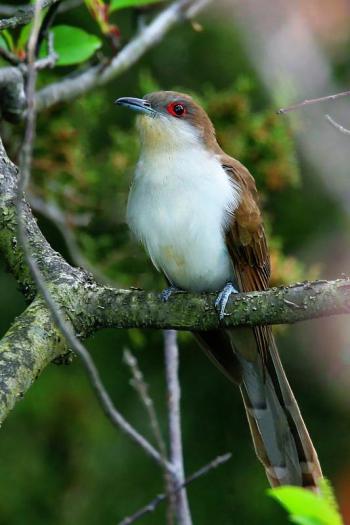Dog Walk Yields Cuckoo Surprise
More often than not, the quiet ambles of our dog walks seem to yield some of our most interesting bird experiences. That was the case yet again last night. We took our little black dog out for one last stroll around the house before bedtime at about ten o’clock. As we contemplated the peaceful night, suddenly from high above, we heard a sound we had not heard in some time—the distinctive throaty rattle of the flight call of the black-billed cuckoo!
With their long tail, rather long downward curved black bill, and bright red skin surrounding the dark eye, black-billed cuckoos are distinctive-looking birds, not that we could see any of those features in the dark as the bird flew high above us. But we’ve seen plenty, and they are quite unlike other familiar birds in our area except for the closely related yellow-billed cuckoo which, you guessed it, has a yellow rather than black bill.
Cuckoos are wonderfully mysterious in many ways.
We heard the flight call of our black-billed cuckoo near the end of the second week of June when, as we pointed out in our last column, birders often expect migration to be over. But for some birds, it’s not, especially some of the species that make the long trek north every spring from their South American wintering grounds. The black-billed cuckoo is one of those species.
Because they are rather reclusive and hard to see, especially when they are not vocalizing as is the case on the wintering grounds, our knowledge of their distribution and life history on their winter habitat is still evolving. But accumulating eBird records are starting to help fill out some understanding—for example, that the species occurs regularly from Colombia south to Bolivia. A glance at May eBird records over the last 10 years shows that some are still on the move in South America into May, and there are a smattering of June records south of the breeding range. There was even one black-billed cuckoo that was photographed one year on Bermuda in mid-June!
To make things even more interesting, black-billed cuckoos (and yellow-billed cuckoos) are known to make nocturnal movements throughout the summer within their breeding ranges. It is unknown why they do this and whether they are moving away from and back again to the same place (perhaps foraging?) or making one-way movements to find new areas in search of a mate and to nest. Black-billed and yellow-billed cuckoos are known for eating lots of the hairy caterpillars that other birds seem to avoid. There is some evidence, at least in years past when they were more abundant, that populations reached high abundance in areas with spikes in gypsy moth or tent caterpillar populations. Do the birds make their night-time movements to try to scout out areas with lots of these caterpillars?
Another fascinating fact about black-billed cuckoos is that although they typically build a nest and raise their own young, there have been well-documented cases of so-called egg-dumping where females leave eggs in another black-billed cuckoo nest. Occasionally, they have been found to parasitize other bird species including gray catbirds, American robins, wood thrushes and at least eight others.
Unfortunately, black-billed cuckoo populations have declined significantly over recent decades so that they are considered a species of at least moderate conservation concern. Much more research is needed to understand the factors responsible for their declines and to learn more about their life history including their migratory behavior.
Jeffrey V. Wells, Ph.D., is a Fellow of the Cornell Lab of Ornithology and Vice President of Boreal Conservation for National Audubon. Dr. Wells is one of the nation's leading bird experts and conservation biologists. He is a coauthor of the seminal “Birds of Maine” book and author of the “Birder’s Conservation Handbook.” His grandfather, the late John Chase, was a columnist for the Boothbay Register for many years. Allison Childs Wells, formerly of the Cornell Lab of Ornithology, is a senior director at the Natural Resources Council of Maine, a nonprofit membership organization working statewide to protect the nature of Maine. Both are widely published natural history writers and are the authors of the popular books, “Maine’s Favorite Birds” (Tilbury House) and “Birds of Aruba, Bonaire, and Curaçao: A Site and Field Guide,” (Cornell University Press).






























.png)
.png)

